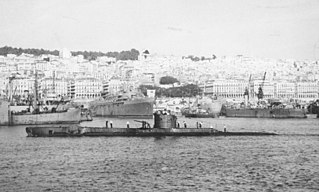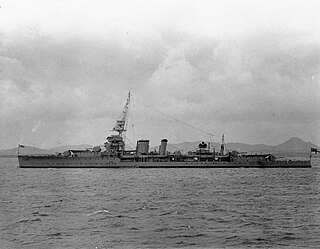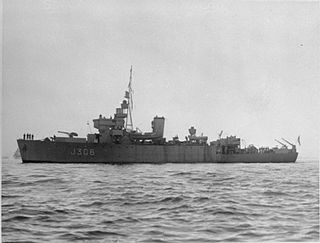
HMAS Nepal (G25/D14) was an N-class destroyer of the Royal Australian Navy (RAN). Launched in 1941 as Norseman, the ship suffered significant damage during an air raid on the John I. Thornycroft and Company shipyard, and during repairs was renamed to recognise Nepal's contribution to the British war effort. Although commissioned into the RAN in 1942, the ship remained the property of the Royal Navy.

HMS Cairo (D87) was a C-class light cruiser of the Royal Navy, named after the Egyptian capital, Cairo. So far she has been the only ship of the Royal Navy to bear the name. She was part of the Carlisle group of the C-class of cruisers.

USS Crowninshield (DD–134) was a Wickes-class destroyer in the United States Navy between World War I and World War II. She was named for Benjamin Williams Crowninshield. In World War II she was transferred to the Royal Navy where she was named HMS Chelsea, and subsequently to the Soviet Navy where she was named Derzky.

USS S-29 (SS-134), was a first-group S-class submarine of the United States Navy. During World War II, she also served in the Royal Navy as HMS P556.

HMS Universal (P57) was a Royal Navy U-class submarine built by Vickers-Armstrong at Newcastle upon Tyne. So far she has been the only ship of the Royal Navy to bear the name Universal.

HMS Ceres was a C-class light cruiser of the Royal Navy. She was the name ship of the Ceres group of the C-class of cruisers.

HMS Durban was a Danae-class light cruiser of the Royal Navy. She was launched from the yards of Scotts Shipbuilding and Engineering Company on 29 May 1919 and commissioned on 1 November 1921.
HMS Cricket was the name given to a Royal Navy shore establishment on the River Hamble from 1943 to 1946. This name was previously used by the Insect-class gunboat Cricket (1915) that was scrapped in 1942.
HMIS Gondwana was a World War II Flower-class corvette of the Royal Indian Navy (RIN). She was originally ordered for and commissioned as HMS Burnet of the Royal Navy, but transferred to RIN immediately upon commissioning.
HMS Tyler (K576) was a British Captain-class frigate of the Royal Navy in commission during World War II. Originally constructed as a United States Navy Buckley-class destroyer escort, she served in the Royal Navy from 1944 to 1945.

The second HMS Foley (K474) was a British Captain-class frigate of the Royal Navy in commission during World War II. Originally constructed as the United States Navy Evarts-class destroyer escort USS Gillette (DE-270), she served in the Royal Navy from 1943 to 1945 and in the U.S. Navy as USS Foley (DE-270) from August to October 1945.

HMS Gore (K481) was a British Captain-class frigate of the Royal Navy in commission during World War II. Originally constructed as the United States Navy Evarts-class destroyer escort USS Herzog (DE-277), she served in the Royal Navy from 1943 to 1946.
HMS Keats (K482) was a British Captain-class frigate of the Royal Navy in commission during World War II. Originally constructed as the United States Navy Evarts-class destroyer escort USS Tisdale (DE-278), she served in the Royal Navy from 1943 to 1946.

The second HMS Vanity was a V-class destroyer built for the Royal Navy during World War I that saw service in World War II.

HMS Advantage was a Favourite-class tugboat of the Royal Navy during the Second World War. Built in the United States, she was transferred to the Royal Navy under Lend-Lease. Advantage served until the end of the war with the Royal Navy and was returned to the United States postwar. Sold to a Chinese merchant shipping company, she served successively as 109, Ming 309, and Kaoshiung until her 1965 scrapping.

HMS Destiny was a Favourite-class tugboat of the Royal Navy during World War II.

HMS Eminent was a Favourite-class tugboat of the Royal Navy during World War II.

HMS Favourite was a Favourite-class tug of the Royal Navy during World War II.

HMS Gardenia was a Flower-class corvette that served in the Royal Navy and was built by William Simons and Company in 1940. She was named after Gardenia. Commissioned in 1940, rammed and sunk by HMS Fluellen on 9 November 1942.

HMS Fly (J306) was a reciprocating engine-powered Algerine-class minesweeper during the Second World War. She survived the war and was sold to Iran in 1949 as IISPalang.















